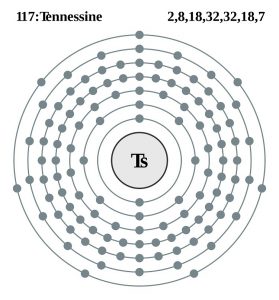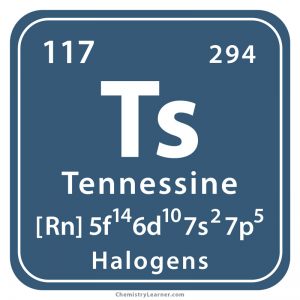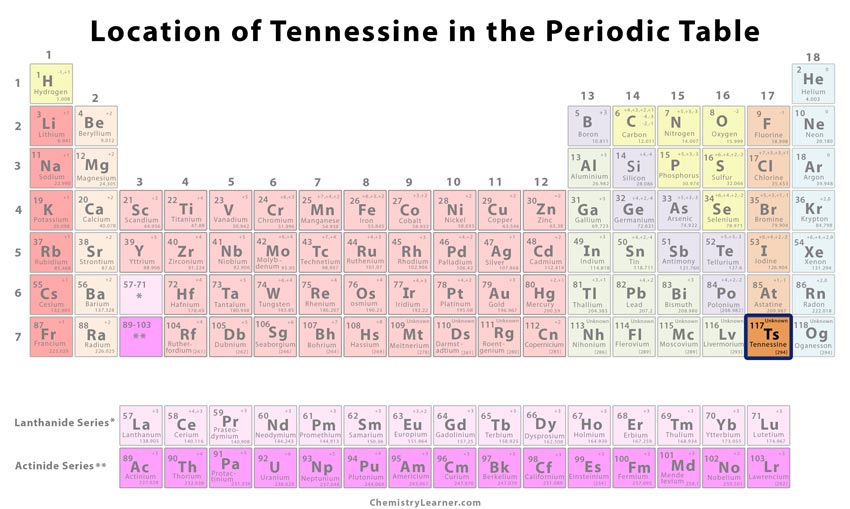Tennessine
What is Tennessine
Tennessine (pronounced as TEN-ess-een [2]), represented by the chemical symbol Ts, is a synthetic, radioactive element [1] belonging to the family of halogens [9]. Of its 2 known isotopes, Ts 292 and Ts 294 [1], the latter is more stable with a half-life of approximately 80 milliseconds [2]. It alpha decays into moscovium-290 [2].
Where Is It Found
The alkali metal does not occur naturally on earth [3]. Only a small amount has been synthesized in laboratories [1].
History
Origin of Its Name: It is named after Tennesse, a US state [1].
Who Discovered It: Scientists from the Joint Institute of Nuclear Research (JINR) in Dubna, Russia, the Lawrence Livermore National Laboratory (LLNL) in California, USA, and the Oak Ridge National Laboratory (ORNL) in Tennesse, USA [1].
How Was Tennessine Discovered
In 2015, IUPAC confirmed the discovery of the element by a collaboration of scientists from JINR, LLNL and ORNL [1]. They had produced it on April 5, 2010, by bombarding berkelium 249 atoms with calcium 48 ions [2].
Tennessine Identification |
|||
| Atomic Number | 117 [1] | ||
| CAS Number | 87658-56-8 [1] | ||
| Position in the periodic table | Group | Period | Block |
| 17 [1] | 7 [1] | p [1] | |
Properties and Characteristics of Tennessine
General Properties |
|
| Atomic mass | 294 atomic mass units [1] |
| Atomic weight | 294 [1] |
Physical Properties |
|
| Color/appearance | Unknown [3] |
| Melting point/freezing point | Unknown [1] |
| Boiling point | Unknown [1] |
| Density | Unknown [1] |
| State of matter at room temperature (normal phase) | Solid [1] |
| Thermal conductivity | N/A [8] |
Chemical Properties |
|
| Oxidation state/Oxidation number | [+1], [+3], [+5] [1] |
| Reactivity | Unknown [5] |
Atomic Data of Tennessine (Element 117)
| Valence electrons | 7s27p5 [6] (predicted depending on its position in periodic table) | ||||||
| Electron configuration (noble gas configuration) | [Rn] 5f146d107s27p5 [1] | ||||||
| Atomic structure | |||||||
| – Number of Electrons | 117 [3] | ||||||
| – Number of Neutrons | 177 [3] | ||||||
| – Number of Protons | 117 [3] | ||||||
| Energy levels [3] | |||||||
| – First Energy Level | 2 | ||||||
| – Second Energy Level | 8 | ||||||
| – Third Energy Level | 18 | ||||||
| – Fourth Energy Level | 32 | ||||||
| – Fifth Energy Level | 32 | ||||||
| – Sixth Energy Level | 18 | ||||||
| – Seventh Energy Level | 7 | ||||||
| Radius of atom | |||||||
| – Atomic Radius | Unknown [1] | ||||||
| – Covalent Radius | 1.65 Å [1] | ||||||
| Electronegativity | N/A [8] | ||||||
| Ionization energy
(kJmol-1) [1] |
1st | 2nd | 3rd | 4th | 5th | 6th | 7th |
| – | – | – | – | – | – | – | |

Tennessine Electron Configuration (Bohr Model)
Tennessine Uses
Due to its miniscule production, its use is restricted to research purposes [1].
Is It Dangerous
Being highly radioactive, it can cause harm if present in significant amounts [1, 3].
Interesting Facts
- IUPAC named Ts along with the elements oganesson (Og), moscovium (Mc) and nihonium (Nh) on 28th November 2016 [4].
- It had been given a placeholder name ununseptium (with symbol uus), representing its atomic number, before being officially named by IUPAC.
Tennessine (Ununseptium) Cost
Unknown, as a tiny amount of it is available till date [3].
- References
- http://www.rsc.org/periodic-table/element/117/tennessine
- https://education.jlab.org/itselemental/ele117.html
- https://www.chemicool.com/elements/tennessine.html
- https://iupac.org/iupac-announces-the-names-of-the-elements-113-115-117-and-118/
- https://www.webelements.com/tennessine/chemistry.html
- https://www.schoolmykids.com/learn/interactive-periodic-table/Ts-Tennessine/
- https://www.americanelements.com/tennessine.html
- https://www.americanelements.com/tennessine.html
- https://www.livescience.com/41459-facts-about-ununseptium.html







nice blog thanks for sharing
Thank you for sharing such valuable information. Highly informative